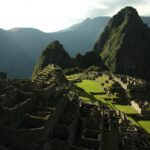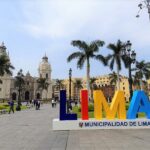If you’re looking for an off-the-beaten-path adventure in the Peruvian jungle, travel to Chachapoyas. Its gorgeous nature, ancient citadels and fascinating mummies make it a great place to spend more than a couple of days.
Planning your trip to Chachapoyas?
Don’t miss out on the best things that this mystical region has to offer:
Best tours in Chachapoyas:
1. Gocta Waterfall hike
2. Kuelap Fortress tour, the citadel on top of a mountain
3. Sarcophagi of Karajia, at the cliff of a mountain
4. Quiocta caverns, the entrance to the underworld
5. Sonche Canyon
6. Revash Mausoleums
Best hotels in Chachapoyas and around:
1. Gocta Andes Lodge (top hotel in the jungle, near the Gocta Waterfall)
2. La Casa Kuelap Hostal
3. Chachapoyas Backpackers Hostal Boutique
Chachapoyas is one of my favorite destinations in Peru. It’s a place full of attractions that are not yet fully explored and therefore have a special charm.
From exploring ancient ruins to hiking through cloud forests and swimming under huge waterfalls, Chachapoyas offers a world of unforgettable experiences.
Also, since Chachapoyas is not yet a very popular destination to travel in Peru, so you will be able to explore without being surrounded by lots of tourists.
In this guide, I’ll give you the details on everything you need to know to plan your trip, from the must-see sights and the best things to do in Chachapoyas, to insider tips and personal recommendations.
1. Gocta Waterfall, one of the tallest in the world
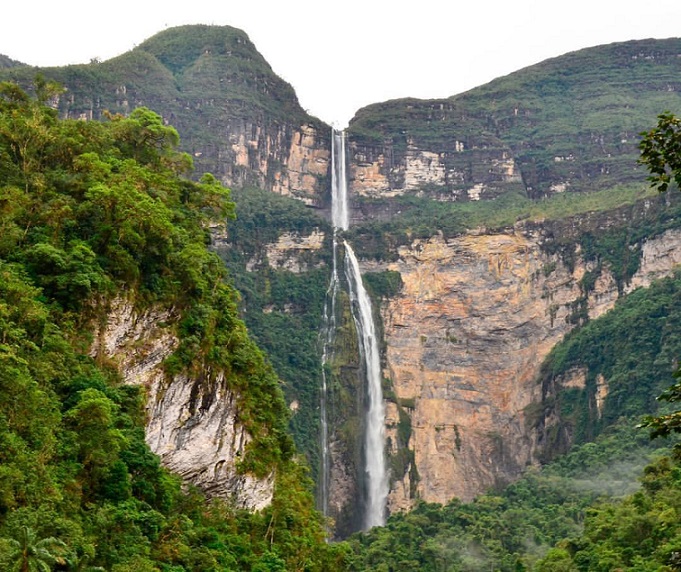
When it comes to natural wonders in Chachapoyas, the Gocta Waterfall is not to be missed. For many people the Kuelap ruins are at their top of their list of things to do in Chachapoyas, but for me it is the hike and visit to the Gocta Waterfall.
The name “Gocta” comes from the Quechua word “Gocct’a,” which means “long-haired waterfall.” And, with a height of 771 meters (around 2500 feet), this waterfall is an absolute stunner.
If you have been to Peru before, you probably know that there are waterfalls everywhere. I travel a lot around Peru, and in my opinion there are no other waterfalls that can compare to Gocta in Chachapoyas. So if you are nature lover, this won’t be just a highlight of your trip to Chachapoyas, but of your trip to Peru as a whole.
The trek to reach the waterfall is an adventure in itself. It takes 3 hours taking you through the jungle and offering stunning views of the waterfall. It is an easy hike though.
If you pay attention, along the way, you will see old carvings made by the Chachapoyas people on some of the steps of the trail.
And that’s not all. The surrounding area is also home to spectacled bears, monkeys, and over 400 bird species. You can even get to see the beautiful orange and black Cock of the Rock, the National Peruvian bird.
What makes the Gocta Waterfall even more special is the local legend that claims a mermaid lives within its cascading waters. The locals say that only a few years ago, the mermaid took one of the men of the nearby village with her.
How to get to Gocta Waterfall
To reach the Gocta Waterfall, you’ll need to take a bus from Chachapoyas to Cocahuayco (an hour away from Chachapoyas). From there, take a motorbike to the small town of Cocachimba.
From Cocachimba, a three-hour hike through nature will take you to the waterfall’s base.
For those who prefer to explore with a guide, I recommend booking this Gocta Waterfall tour. The tour takes you from Chachapoyas and at Cocachimba you will have a local guide take you to the waterfalls.
Pro tip: It’s possible to spend the night in Cocachimba, and there are some small hostels. But if you want to want to spend the night at a really beautiful lodge in the middle of the jungle and with a direct view of the waterfall, stay at Gocta Lodge. They also have a great restaurant, so at least make sure to stop for lunch.
2. Kuelap: a Jungle Fortress
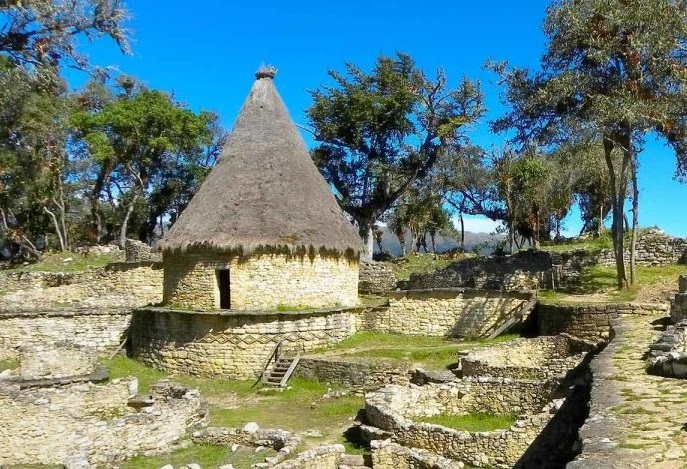
Note: In early 2022, a big wall of the Kuelap fortress fell down. Kuelap was closed for restoration for a year and a half, but in August 2023, it has reopened, at least partially. Entrance to Kuelap will be free until the end of 2023. Just make sure to go early, since for now, the capacity will be for a maximum of 144 visitors per day.
Kuelap
At the top of mountain with amazing views of the the jungle, you can find the Kuelap ruins.
Hundreds of years ago, this was the home of the Chachapoyas people. They were called the Cloud Warriors, as they chose this area, the cloud forest, as their home.
These warrior people were particularly fierce. Apparently, they exposed the heads of their enemies on stakes to show their courage and discourage other tribes from coming to bother them. Especially the Incas, who were they big enemies and who eventually defeated them.
Kuelap is a fortress with very high walls, which surround hundreds of circular stone houses. After Machu Picchu, Kuelap is actually one of the most impressive archaeological sites in Peru.
I remember that the first time I went to Kuelap, many years ago, the hike to get there was very long. I even had to camp mid-way and continue the next day. It was exhausting but really worth it to get to the fortress very early in the morning the following day.
But since 2017 the route is much easier. There’s a cable car that takes you to the fortress in just 20 minutes! Since then, the Kuelap has undergone a tourist boom and is becoming more popular all over the world. If you travel to Chachapoyas and only have time to visit two sites, they should be Kuelap and the Goca Waterfall.
How to get to Kuelap
If you prefer to go there by yourself, from the bus terminal of Chachapoyas, you will have to take a bus that will take you to Nuevo Tingo. The journey takes approximately one hour. From there, you can take a cable car that will take you to the fortress on a trip with spectacular views.
Booking a tour to Kuelap is the other option and a great choice if you are looking for something more organized. The tour takes you to another nearby archaeological site as well, andt he explanations of your local guide can make your trip much more interesting.
3. The Sarcophagi of Karajia
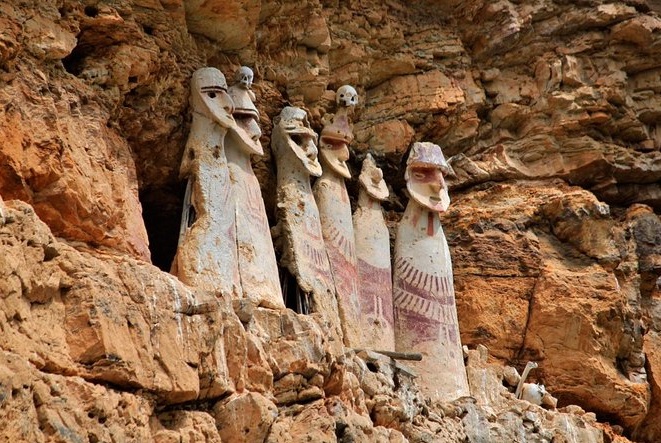
One of the most enigmatic sites that you can visit when you travel to Chachapoyas, are the Sarcophagi of Karajia. I found my visit to the sacrophagi fascinating, and if you are intrigued by mystery and archaology, you will to.
These sarcophagi are the last resting spot of the leaders and the elite of the Chachapoyas people, who lived in the area hundreds of years ago.
The Chachapoyas had great respect for the dead, so to protect their corpses, they built these impressive sarcophagi, huge in size and shaped like humans, and place them on the cliff of a mountain.
Being high up, on hard-to-reach locations, they could rest peacefully while continue to watch over and protect the living from their lofty perch.
Because the location is inaccesible, this means that actually can’t go see them from closeby, but from the bottom of the mountain. Which adds even more mystery to the experience!
How to get to the Sarcophagi of Karajia
If you want to make the trip on your own, you must take a colectivo (van) from Chachapoyas to Luya. This is a 3-hour trip. Once here, take another bus and get off at the town of Cruz Pata. In this place you will find the booth where you can pay the entrance fee and begin the 25-minute walk that takes you to the sarcophagi.
Take into account that colectivos are small and if you are tall your legs will be crumpled. If you want to travel more comfortably I recommend taking a tour to the Sacarcophagi of Karajia, which departs from Chachapoyas city and includes a visit to the Quiocta Caverns.
Tip: If you decide to go by yourself, make sure to go in the early morning. When I went to Karajia I was back at Cruz Pata around 5pm and there weren’t any colectivos back to Chachapoyas anymore. I ended up having dinner and sleeping at the living room of a friendly villager’s house, which was a great experience, but maybe not for everyone!
4. The Quiocta Caverns, an entrance to the underworld

Note: As of June 2023, the caverns are closed to the public until further notice.
If you visit the Karajia Sarcophagi, you have to make a stop at the Quiocta Caverns.
The Quiocta caverns are an entrance to the Andean Uku Pacha, considered by the ancient Peruvians as the entrance to the underworld where spirits and deities live.
In its dark and humid chambers, full of stalctites and stalagmites, with the sound of water from the stream and drops falling from the top, you will feel in a magical place.
Along the way of your descent, you will find very old cave paintings and marine fossil remains embedded in the rock.
To make the place even more mysterious, you can find ancient burials all along the route. The dead are actually honored by the guides who visit the cavers, by performing rituals with coca leaves and praying to their spirits. It is believed that they were the nobles of the Chachapoyas culture.
How to get to the Quiocta Caverns
The best way of visiting the caverns is with a tour. Basically, there’s no other way to do it, since you could easily get lost. The floor is slippery and there is mud everywhere, so you need to know exactly where to step. Besides, your guide will lend you rainboots plus a powerful flashlight.
You can book a tour that takes you both to the Quiocta caverns and the Sarcophagi or Karajia here.
5. Sonche Canyon: one of the deepest in Peru
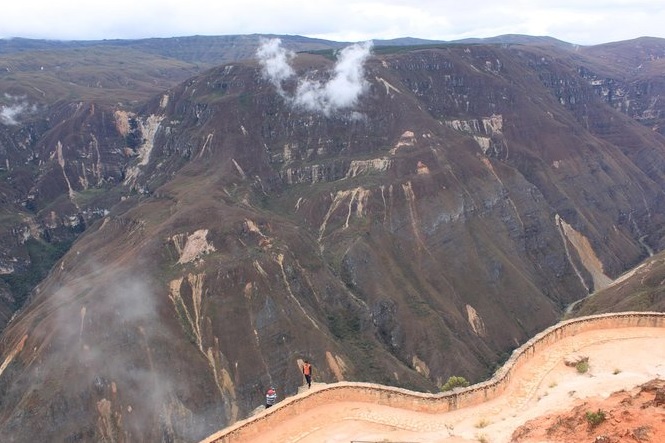
Just a quick 20-minute drive north of Chachapoyas, lies a natural wonder that is sure to take your breath away: the Sonche Canyon.
This canyon, also called Huanca Urco, is one of the most imporantt in Peru, it reaches depths of almost 1000 meters (~3200 feet). Not for the faint of heart or those who suffer from vertigo.
From the top of the canyon, there are many different viewpoints, from where you can enjoy panoramic views of the surrounding mountains and forests. If you have binoculars with you, you will even be able to see the Gocta waterfalls from there!
The community takes care of the maintenance of the tracks, and they charge and entry fee is 3 soles (~USD $0.80). Opening times are 9am to 5pm, except on Sundays, when they close at 3pm.
How to get to Sonche Canyon
At the main square of Chachapoyas you will find several buses that go to the Mirador de Huancas, which is the viewpoint you want to get to. You can do the return in the same way. You will have to pay attention to the time, since the last bus leaves around five in the afternoon back to Chachapoyas.
If you want to take a tour to Sonche Canyon, there’s an interesting tour that takes you not just to the tour but to the near Huanca community as well. The Huancas are famous for their pottery, and the tour includes going to a locall house to witness the pottery process. There, you will be able to join in and make your own ceramics, so it’s a unique experience as well.
Pro tip: The rainy month sare from December to March, so if you visit the canyon in this season make sure to take a raincot and a jacket, as it can get very cold.
6. The Mysterious Revash Mausoleums
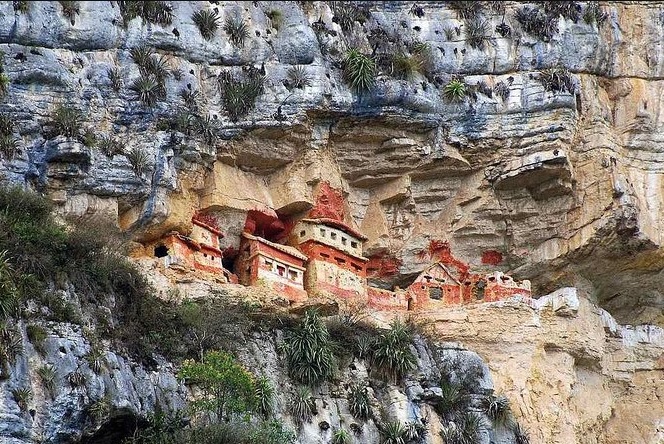
The Revash Mausoleums is a site as magical as the Karajia Sarcophagi.
This is another ancient burial site of the elite of the Chachapoyas people.
But this time, instead of looking at human-shaped sarcophagi, you will be looking at a series of little houses carved into the cliffs of a mountain.
The necropolis resembles a small town, a reflection of how the houses were at the time of the Chachapoyas people. They are decorated with paintings of several symbols, including llamas, T-shaped windows and crosses (interesting! why crosses if they are from before the Europeans arrived?).
Its buildings remain quite well preserved, but they are empty. The tombs were desecrated and the corpses that were found here disappeared years ago.
How to get to the Revash Mausoleums
If you want to go by yourself, you have two options, go from Chachapoyas to either Yerbabuena or San Bartolo towns.
From either town, you will have to walk to the mausoleums. If you start from Yerbabuena, it will take you 2 hours and a half, and 1 hours if you start from San Bartolo. The walk is at the edge of a
Tip: Make sure to start your trip early! You will need to catch a colectivo back to Chachapoyas before noon. Otherwise, you might get stranded in the town!
So actually, the best way to get to the Revash Mausoleums is by tour. You can book this tour to the Revash Mausoleums, which also takes you to the Leymebamba Museum as well.
Yumbilla Waterfall: the 5th tallest in the world
Imagine standing in front of a waterfall that is so tall, it’s hard to see the top. That’s exactly what you’ll experience when you visit Yumbilla waterfall.
Even though Gocta is the most famous waterwall, is not the tallest. Moreover, Yumbilla is actually the second tallest waterfall in the country (after a waterfall in the Junin region) and the fifth tallest in the world. It almost 900 meters (~3000 feet) tall!
The path to Yumbilla is easy to walk and it will take you 3 hours to get there. However, you shouldn’t take your eyes off the ground, as the moisture and fallen branches can make you slip. At every turn, you will find a rich variety of trees and beautiful flowers, from roses to orchids.
On the way you will also see a lot of wildlife. Try to spot a Cocks of the Rocks or the Marvelous Spatuletail (more about this unique hummingbird below). And at sunset it is possible to find monkeys.
What makes this trek even better is that you will find two other very tall waterfalls, the Medio Cerro and the Cristal Waterfall, along the way.
Tip: The best time to visit the waterfall is during the rainy season, which is November to April. In this season you will be able to appreciate the waterfall at its fullest and the landscape becomes greener.
How to get to Yumbilla
From Chachapoyas, take a bus to Pedro Ruiz. The next step will be to take a tuk tuk to Cuispes. From Cuispes you will have to walk for two and a half hours.
Tip: Since Cuispes is a very small town, I suggest you tell the tuk tuk driver to pick you up at a certain time. Otherwise you might not find a way to get back to Pedro Ruiz. Or otherwise you can spend the night at Cuispes, which has a nice hotel called La Posada de Los Cuispes.
Leo Caverns

Imagine going to till the land every day, only to stumble upon the entrance to a cave on your property. That’s precisely what happened to Leuvigildo López, affectionately known as “Leo” by the locals in Omia.
While clearing some stones on his farm, he discovered a hole. With his children, he descended into the depths of the earth, discovering a vast cavern that has since been declared a private conservation area.
Divided into seven levels, it features a room so expansive that its columns – formed by stalactites and stalagmites – tower up to 80 meters high.
The light streams in from several angles, casting iridescent and golden hues on the formations. It feels like a magical and mysterious place, and it even has a waterfall inside.
If you wish to explore the cave, you must coordinate with the López family, who own the land on which it sits.
How to get to the Leo Caverns
From the bus terminal, you have to travel by combi from Chachapoyas to Mendoza. They charge 15 soles per person and it’s a 3-hour drive. From this town you have to take a truck or van that connects Mendoza with Omia and charges another five soles. It is a half hour drive and you have to tell the driver that you are going to Leo’s cave so that he stops just before the bridge at the entrance of the town.
Once there, you will have to rent safety equipment from the cave owner in order to go down safely.
Otherwise, you can take a tour from a local company, but there are very few who offer it.
Huaylla Belen Valley
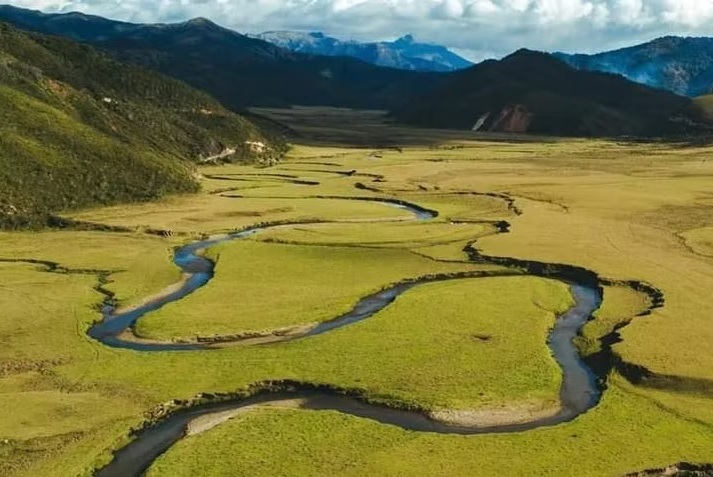
If you already visited Gocta Waterfall and want to go for another trekking adventure, Huaylla Belen valley is the place.
The river that crosses the valley is also called “the silver serpent”, and it’s easy to understand why. The river’s appearance is striking, as it contrasts sharply against the ground, resembling a ribbon snaking its way through the landscape.
Besides the great views, the valley is also home to several hiking trails and archaeological remains. You might even find some interesting animals along the way, like a spectacled bear along the way!
How to get to Huaylla Belen Valley
Take a colectivo from the Chachapoyas bus terminal to the town of Colcamar. From there you can either walk or take a taxi, which will leave you at certain point from where you have to walk. It is important to negotiate in advance with a taxi or to find out the times of the colectivos to find transportation back to both Colcamar and Chachapoyas.
The excursion to Huaylla Belen Valley has become one of the most popular in Chachapoyas, so you can find several tour companies in the town that will take you there.
Lake of the Condors
Are you looking for even more adventure in the jungle? Then Laguna de Los Condores, also known as the Lagoon of the Mummies, will not disappoint you. It is not so close to the city of Chachapoyas though, so you will need first to travel to Leymebamba and from there start hiking.
The lake is a nine-hour trek on foot and horseback from the town of Leymebamba, winding through lush jungle and past stunning vistas. It’s a three-day trip to explore the full archaeological complex surrounding the lagoon, and it’s well worth the effort.
The legends surrounding the lagoon are just as captivating as the journey itself. Local lore tells of condors that once inhabited the area, guarding the site and its treasures from harm. These majestic birds vanished once the mummies were removed from the site, so so locals believe in a curse surrounding the archaeological complex.
There are also rumors about lost Incan gold hidden in the depths of the lagoon, with tales of treasure destined for the liberation of Atahualpa, the Inca leader captured by the Spanish.
Around the lake you will find mausoleums and cave paintings, as well as unique and intricate symbolic decorations. And don’t miss the opportunity to visit the Leymebamba Museum, which houses over 200 mummies that were once at the mausoleums near the lagoon.
Surely a trip to the Lake of the Condors will be an unforgettable experience when you travel to Chachapoyas.
How to get to Lake of the Condors
To get to the lake, you need to take a bus to Leymebamba, which is 2 hours away from Chachapoyas.
Once in Leymebamba, you must hire a local guide who will lead you to the archaeological complex. From there, you will begin your 9-hour walk.
Tip: The rains are an unavoidable problem during the tour because the terrain becomes swampy, slippery and it is very cold. It is best to visit the lake outside of rainy season, from May to October.
Best hotels in Chachapoyas and around
Gocta Andes Lodge
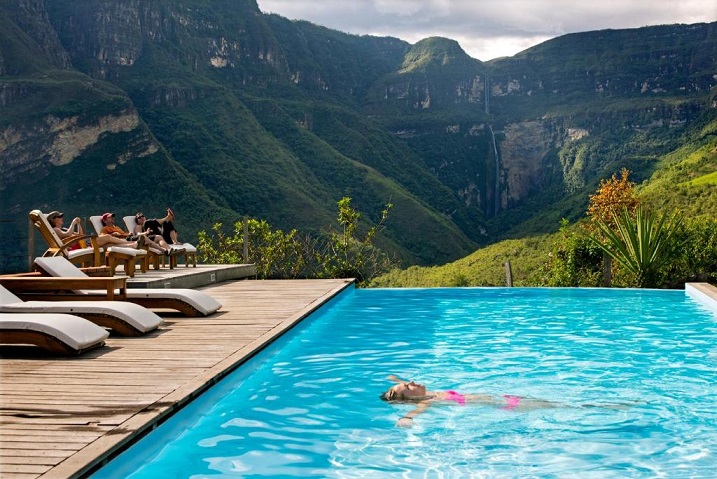
Among all the options in the area, this hotel is the absolute winner. The lodge is 1 hour from Chachapoyas, in the town of Cocachimba (the town from where the hike to the Gocta Waterfalls starts).
It features comfortable and spacious rooms with a terrace. From every room, you get spectacular views of the Gocta waterfall and the surrounding jungle. It also has a beautiful swimming pool. The hotel’s restaurant serves delicious local cuisine made with fresh, organic ingredients.
Book your stay at Gocta Andes Lodge here (2 nights minimum)
La Casa Kuelap Hostal
This cozy 3-star hotel in Chachapoyas is located in an old house with a beautiful patio. The rooms are spacious and well-maintained, and guests can enjoy a well-equipped kitchen where they can cook their own meals. The hotel also offers a complimentary breakfast, and its location makes it easy to explore the city and nearby attractions.
Book a room at La Casa Kuelap Hostal here.
Chachapoyas Backpackers Hostal Boutique
This charming hostel offers both private rooms and shared dorms, all of which are clean and comfortable. Guests rave about the friendly and helpful staff, as well as the great views of the city. Located in a quiet area of town of Chachapoyas, the hostel is the perfect place to relax and unwind after a long day of exploring. And don’t miss out on the delicious breakfast served each morning, which is a highlight for many guests.
Book a room at the Chachapoyas Backpackers Hostal Boutique here.
How to get to Chachapoyas
By Plane
The easiest and most convenient way to travel to Chachapoyas is by air. The only airline that flies there is ATSA airlines.
The only issue is that they don’t depart every day, you have to check on their website. Also, since the flights are on small commuter planes, they can be prone to turbulence and can cause motion sickness.
If you want to travel to Chachapoyas on a different day than their schedule shows, you have other options:
You can take a direct flight from Lima to either Jaén, which takes around 1 hour and 20 minutes.
Once you arrive in Jaén or Tarapoto, you can take a bus or hire a private car to drive to Chachapoyas. The trip from Jaén to Chachapoyas takes around 4-5 hours by bus.
By Bus
If you’re looking for a more budget-friendly option to travel to Chachapoyas, you can take a bus from various cities in northern Peru, including Chiclayo, Trujillo, Cajamarca, and Piura.
- From Jaén to Chachapoyas: the bus ride takes around 4-5 hours.
- From Chiclayo to Chachapoyas: the bus ride takes around 9-10 hours.
- From Trujillo to Chachapoyas: the bus ride takes around 12-13 hours.
- From Cajamarca to Chachapoyas: the bus ride takes around 8-9 hours.
- From Piura to Chachapoyas: the bus ride takes around 14-15 hours.
Keep in mind that the bus routes to Chachapoyas can be long and winding, so if you suffer from motion sickness when you travel, it’s a good idea to bring some medication with you.
Chachapoyas is a land of mysteries, legends, and adventures waiting to be discovered. As you can see, you won’t run out of mystery and interesting things to do when you travel to Chachapoyas.
From the stunning Gocta waterfall to Kuelap Fortress and the enigmatic mummies scattered around, this region is a true hidden gem of Peru.

